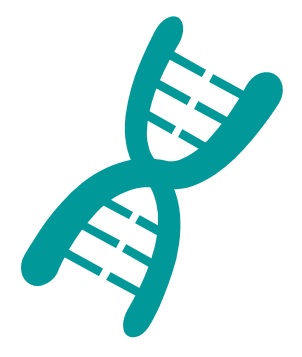Protirelin – Thyrotropin-releasing hormone (TRH) (CAS: 24305-27-9)
Thyrotropin-releasing hormone (TRH)
Thyrotropin-releasing hormone (TRH) is a tripeptide hypothalamic regulatory hormone that regulates the release of thyroid-stimulating hormone (TSH),as well as prolactin (for breasts growth and milk production during and after pregnancy).
To obtain thyrotropin-releasing hormones,6 pro-TRH peptides have first to be obtained from the larger preproTRH precursor (UniProt: P20396). These octapeptides are then cleaved between Arginine/Glutamine and Glutamine/Lysine residues to release 6 Gln-His-Pro-Gly peptides that will be enzymatically converted in pGln-His-Pro-NH2 peptides (pGln representing pyroglutamine).
After TRH maturation (1) in neurons located in the pituitary gland,the hormone will be transported along axons (2) to reach the hypophyseal portal system via exocytosis (3). Once the thyrotrophs reached,thyrotropin-releasing hormone binds TRH-receptor (4) to enable TSH synthesis and secretion that will stimulate thyroid follicular cells to produce thyroid hormones Triiodothyronine (T3) and Tetraiodothyronine (T4).
![[Glu2]-TRH_pGluGLuPro-NH2_CAS: 85541-78-2_ and TRH peptide_CAS: 24305-27-9_SB-PEPTIDE scheme: TRH metabolism pathway](https://www.sb-peptide.com/image/Schema-TRH-pathway-webpage-Glu2-TRH-1024x565.jpg)
TRH implication in hypothyroidism and cholinergic neuronal activity
TRH being directly involved in TSH release,deficiency of this hormone has been found to be related to secondary hypothalamic hypothyroidism. This condition can affect all body functions,causing various symptoms of different severity from fatigue to brittle nails,cold intolerance or joint pain even.
On the contrary,even though no case of excessively high levels of TRH was observed up to now,studies showed the cholinergic effect of TRH in mouse brain. In 1991,for instance,M. G. Giovannini & al. associated TRH administration,s.c. or via local perfusion,with acetylcholine (ACh) release increase from rodents’ cortex and hippocampus,which suggested the strong stimulant action of TRH on cortical and hippocampal cholinergic pathways.
TRH applications
TRH is indicated as adjunctive agent in the diagnostic of potential thyroid disfunction. Even though TRH stimulation test isn’t yet approved by the U.S. Food and Drug Administration (FDA),the intravenous injection of the hormone to the patient’s bloodstream is sometimes used to distinguish different types of thyroid problems. Due to the concern expressed by the FDA,TRH is primarily used as a research tool mainly in the United States.
Besides its role in endocrinology,the ability of TRH to promote wound healing by accelerating skin’s re-epithelization has also been demonstrated a few years ago.
SB-PEPTIDE also offers [Glu2]-TRH analog for its wide range of biological effects and its stability upon enzymatic degradation.
Technical specification
 |
Sequence : pGluHisPro-NH2 / ZHP-NH2 |
 |
MW : 362.38 g/mol (C16H22N6O4) |
 |
Purity : > 95% |
 |
Counter-Ion : TFA Salts (see option TFA removal) |
 |
Delivery format : Freeze dried in propylene 2mL microtubes |
 |
Other names : Protirelin |
 |
Peptide Solubility Guideline |
 |
Bulk peptide quantities available |
Price
| Product catalog | Size | Price € HT | Price $ USD |
| SB309-5MG | 5 mg | 220 | 275 |
| SB309-25MG | 25 mg | 1100 | 1375 |
References
Front. Neuroendocrin. Jan 2019;52:29-43. doi: https://doi.org/10.1016/j.yfrne.2018.06.006
The forgotten effects of thyrotropin-releasing hormone: Metabolic functions and medical applications
Thyrotropin-releasing hormone (TRH) causes a variety of thyroidal and non-thyroidal effects,the best known being the feedback regulation of thyroid hormone levels. This was employed in the TRH stimulation test,which is currently little used. The role of TRH as a cancer biomarker is minor,but exaggerated responses to TSH and prolactin levels in breast cancer led to the hypothesis of a potential role for TRH in the pathogenesis of this disease. TRH is a rapidly degraded peptide with multiple targets,limiting its suitability as a biomarker and drug candidate. Although some studies reported efficacy in neural diseases (depression,spinal cord injury,amyotrophic lateral sclerosis,etc.),therapeutic use of TRH is presently restricted to spinocerebellar degenerative disease. Regulation of TRH production in the hypothalamus,patterns of expression of TRH and its receptor in the body,its role in energy metabolism and in prolactin secretion are addressed in this review.
Neuropeptides. Dec 2015;54:73-77. doi: https://doi.org/10.1016/j.npep.2015.08.001
Role of thyrotropin-releasing hormone in prolactin-producing cell models
Thyrotropin-releasing hormone (TRH) is a hypothalamic hypophysiotropic neuropeptide that was named for its ability to stimulate the release of thyroid-stimulating hormone in mammals. It later became apparent that it exerts a number of species-dependent hypophysiotropic activities that regulate other pituitary hormones. TRH also regulates the synthesis and release of prolactin,although whether it is a physiological regulator of prolactin that remains unclear. Occupation of the Gq protein-coupled TRH receptor in the prolactin-producing lactotroph increases the turnover of inositol,which in turn activates the protein kinase C pathway and the release of Ca2 + from storage sites. TRH-induced signaling events also include the activation of extracellular signal-regulated kinase (ERK) and induction of MAP kinase phosphatase,an inactivator of activated ERK. TRH stimulates prolactin synthesis through the activation of ERK,whereas prolactin release occurs via elevation of intracellular Ca2 +. We have been investigating the role of TRH in a pituitary prolactin-producing cell model. Rat pituitary somatolactotroph GH3 cells,which produce and release both prolactin and growth hormone (GH),are widely used as a model for the study of prolactin- and GH-secreting cells. In this review,we describe the general action of TRH as a hypophysiotropic factor in vertebrates and focus on the role of TRH in prolactin synthesis using GH3 cells.
PLOS ONE. 2013 Sept 2;8(9):e73596. doi: https://doi.org/10.1371/journal.pone.0073596
Thyrotropin-Releasing Hormone (TRH) Promotes Wound Re-Epithelialisation in Frog and Human Skin
There remains a critical need for new therapeutics that promote wound healing in patients suffering from chronic skin wounds. This is,in part,due to a shortage of simple,physiologically and clinically relevant test systems for investigating candidate agents. The skin of amphibians possesses a remarkable regenerative capacity,which remains insufficiently explored for clinical purposes. Combining comparative biology with a translational medicine approach,we report the development and application of a simple ex vivo frog (Xenopus tropicalis) skin organ culture system that permits exploration of the effects of amphibian skin-derived agents on re-epithelialisation in both frog and human skin. Using this amphibian model,we identify thyrotropin-releasing hormone (TRH) as a novel stimulant of epidermal regeneration. Moving to a complementary human ex vivo wounded skin assay,we demonstrate that the effects of TRH are conserved across the amphibian-mammalian divide: TRH stimulates wound closure and formation of neo-epidermis in organ-cultured human skin,accompanied by increased keratinocyte proliferation and wound healing-associated differentiation (cytokeratin 6 expression). Thus,TRH represents a novel,clinically relevant neuroendocrine wound repair promoter that deserves further exploration. These complementary frog and human skin ex vivo assays encourage a comparative biology approach in future wound healing research so as to facilitate the rapid identification and preclinical testing of novel,evolutionarily conserved,and clinically relevant wound healing promoters.
